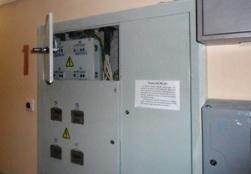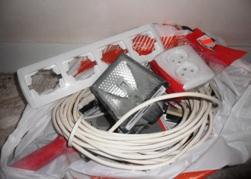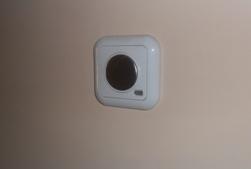Categories: Featured Articles » Electrician at home
Number of views: 97825
Comments on the article: 17
Popular about apartment wiring
 The electrical wiring in the apartment begins with an electric meter. His appointment is known to all. The meter is followed by machines. They automatically turn off the electricity as a result of short circuits and overload in the mains. A cable runs from each machine into the apartment, on which all sockets, switches and chandeliers are already "hung".
The electrical wiring in the apartment begins with an electric meter. His appointment is known to all. The meter is followed by machines. They automatically turn off the electricity as a result of short circuits and overload in the mains. A cable runs from each machine into the apartment, on which all sockets, switches and chandeliers are already "hung".
Overload in each cable branch occurs if you turn on devices whose power is greater than the one your cable branch with a machine is designed for. When purchasing electrical appliances, always read in the description how much power they consume. To determine what power your wiring is designed for, look at what is written on your machines.
The numbers in Amperes on each machine correspond to the amount of current that it is capable of passing. This current value is related to the power consumption of your appliances. To estimate the total allowable power of your electrical appliances on a single cable branch with a machine, you need to multiply the number on the machine by 220 (network voltage in volts).
That is, if 16A is written on the machine, multiply 16 by 220 and get the allowable power consumption in the region of 3000 watts. So, in this thread you can painlessly connect, say, three heaters of 1 kW each, well, maybe even a table lamp or a TV (though, depending on which one, see TV passport). The cybernetic accuracy of calculations is useless here, it must be considered with tolerances in the direction of increasing reliability.
Now about the cables themselves, which stretch from your machines. The first thing to keep in mind is that it is undesirable to use wires from different materials. In particular, copper with aluminum in electrical wiring - this is a time bomb, because such contact catalyzes the oxidation processes. Therefore, if you decide not to change wiring completely, but just add a couple of outlets, then you need to take the cable with cores of the same metal that is already laid to you.
 If the wiring changes completely, then it is most reliable to stop on a cable with copper conductors. If the house is relatively new, then it most likely has grounding, then you need to take a three-core cable. In old houses it happens that there is no grounding, then a two-core cable is enough.
If the wiring changes completely, then it is most reliable to stop on a cable with copper conductors. If the house is relatively new, then it most likely has grounding, then you need to take a three-core cable. In old houses it happens that there is no grounding, then a two-core cable is enough.
But, if you look in perspective, then over time grounding in old houses, nevertheless, it may appear, and ZhEKi periodically think about it. Therefore, it is advisable to stretch all the same three-wire wires, where the third core will be temporarily not involved, so as not to have problems with remaking electrics in the future.
Now about the diameter of the wires in the cable. The diameter of the cores directly depends on the expected load from your electrical appliances. Here it is necessary to divide the total power of the devices in watts by 220 (mains voltage in volts) and obtain the magnitude of the current in amperes, i.e. Knowing the diameter of the cable cores, you can determine the maximum current that can be passed through it.
The cross-sectional area of the conductors of wires and cables is taken at the rate of 1 mm2 at 10 amperes. That is, if the current strength is 20 A, then the closest existing wire cross-section will be 2.5 mm2. Very strong accuracy, again, is useless, and you need to take a figure in the direction of increasing reliability.
It is important that the diameter of the cores in the cable is commensurate with the number of amperes indicated on the machine. It’s risky to put a cable with a cross section of, for example, 2.5 mm2 to the 32A machine, because, as in the case of an overload, the wires will burn before the machine breaks out.
There are two main cable routing options. The first is to pull the cable from the machine around the perimeters of all rooms in one piece, and then connect sockets, switches and chandeliers to it. The advantage is that you do not need to make junction boxes, but rather limit yourself to drilling holes in the walls.In all other respects, nothing good: the cable consumption is higher, the reliability of the wiring is lower.
The second option is laying the cable according to the "star" scheme. In this case, we pull the cable from the machine to the main junction box. This will be the so-called highway. From the junction box using soldering or terminals, we distribute the cable into the rooms.
 It is advisable to make a separate trunk for lighting and switches, and a separate one for sockets. Naturally, each highway is connected to "its" machine. If the apartment has an electric stove or a similar powerful consumer, then it is better to stretch a separate highway for such equipment with a separate automatic machine, designed for the corresponding current.
It is advisable to make a separate trunk for lighting and switches, and a separate one for sockets. Naturally, each highway is connected to "its" machine. If the apartment has an electric stove or a similar powerful consumer, then it is better to stretch a separate highway for such equipment with a separate automatic machine, designed for the corresponding current.
Calculations of loads and wire diameters should be performed according to the above procedure. For example, in most cases, a cable with 1.5 mm conductors is sufficient for lighting2 and a 16A machine. For sockets, it is better to take a machine at least 25A, from it a trunk, say, 4mm2 to the junction box, and from the junction box to the premises, already extend the cable by 2.5 mm2.
Laying the cable in the premises is a fairly creative process. The main thing is that the cable runs parallel to the architectural joints, the distance from outlets to metal pipes is more than 50 cm, horizontal cable routes lie within 25 cm from the ceiling and within 50 cm from the floor.
However, if there is a desire to comply with the standards, then it is worthwhile to familiarize yourself with the building codes that are easy to find on the Internet. Well, the information described in this article is quite enough to, if not posting yourself, then at least check your contractor.
We recommend reading:How to choose the right cable cross section for wiring
See also at bgv.electricianexp.com
:
